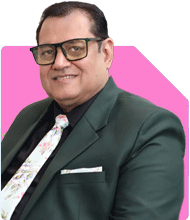Dr Ashish Sehgal | Answer |Ask -Follow
Relationships Expert, Mind Coach - Answered on Jan 09, 2024

Hi, I am married from last 15 year, having a daughter , my realtion with my wife is very bad, she is like this since start of marriage, our is arrange marriage. She didn't want any kind of responsibility, she always want to go out and if possible do shopping, if I asked not to over spend she thinks not sure what and create scene. She fight with everyone even in office or with her parents, she blames other for all this, never ever think she can be wrong, she is having a feeling if you correct her , she not going to like it, she will say no need to teach me , I know. She even not hving very good relationship with my daughter, she is in class 10th and staying in baording. I am hving 2 flat just like jodi flat adjacant to each other, i am staying in one and she is in another , she hardly let me hv sex, but she talks or chat with stranger whole night, i try to question her but she started fighting, she didn't listen and do what ever she want, if u question she will fight, i really don't know how to handle this situation, I am feeling trapped and she is accusing me for all the mess. We had fight lots of time , we abused each other during fight a lot , but the problem still persist nothing changed in 15 years recently after fight i stop talking with her . Not sure how I should move forward , i talked with my daughter and she also suggesting me leave her for some time she will realize , should i go for divorce or how to move forward.
It's important to remember that ultimately, the decision to stay in or leave a relationship is up to the individual. Here are some things you can do to help you move forward:
1. Seek professional help: Consider seeing a therapist or counselor who can help you work through your feelings and provide guidance on how to move forward.
2. Take care of yourself: Make sure you're taking care of your own physical and emotional needs. This can include getting enough sleep, eating a healthy diet, and engaging in activities that you enjoy.
3. Set boundaries: If your wife's behavior is causing you distress, it's important to set boundaries. This can include setting limits on spending, or establishing rules around communication.
4. Consider couples therapy: If you're both willing, couples therapy can be a helpful way to work through issues in your marriage and improve communication.
5. Think about your options: If you're considering divorce, it's important to think carefully about your options. Consider speaking with a lawyer who can provide guidance on the legal aspects of divorce.
Remember, every situation is unique, and there's no one-size-fits-all solution. Take the time to consider your options and make the decision that's best for you and your family.
You may like to see similar questions and answers below
Anu Krishna |1746 Answers |Ask -Follow
Relationships Expert, Mind Coach - Answered on Feb 08, 2024
Kanchan Rai |646 Answers |Ask -Follow
Relationships Expert, Mind Coach - Answered on May 04, 2024
Kanchan Rai |646 Answers |Ask -Follow
Relationships Expert, Mind Coach - Answered on Dec 29, 2024
Dr Upneet Kaur |73 Answers |Ask -Follow
Marriage counsellor - Answered on Apr 16, 2025
Kanchan Rai |646 Answers |Ask -Follow
Relationships Expert, Mind Coach - Answered on Dec 12, 2025
Ravi Mittal |677 Answers |Ask -Follow
Dating, Relationships Expert - Answered on Dec 12, 2025
Ramalingam Kalirajan |10881 Answers |Ask -Follow
Mutual Funds, Financial Planning Expert - Answered on Dec 12, 2025
Ramalingam Kalirajan |10881 Answers |Ask -Follow
Mutual Funds, Financial Planning Expert - Answered on Dec 12, 2025
Reetika Sharma |423 Answers |Ask -Follow
Financial Planner, MF and Insurance Expert - Answered on Dec 12, 2025
Reetika Sharma |423 Answers |Ask -Follow
Financial Planner, MF and Insurance Expert - Answered on Dec 12, 2025
Reetika Sharma |423 Answers |Ask -Follow
Financial Planner, MF and Insurance Expert - Answered on Dec 12, 2025
Reetika Sharma |423 Answers |Ask -Follow
Financial Planner, MF and Insurance Expert - Answered on Dec 12, 2025
Reetika Sharma |423 Answers |Ask -Follow
Financial Planner, MF and Insurance Expert - Answered on Dec 12, 2025
Mayank Chandel |2572 Answers |Ask -Follow
IIT-JEE, NEET-UG, SAT, CLAT, CA, CS Exam Expert - Answered on Dec 11, 2025



























